Allow me to take you down memory lane to the time when you graduated from school. It is a bittersweet time for everyone. We were all still unsure of the courses or universities to select. Even though we had a long list of colleges, we would still consult everyone around. The decision became harder when we saw ads of lush-green campuses, events, and more from colleges that weren’t on our shortlist. But, in the end, we probably ended up choosing the ones that gave us the best student experience during our search.
That’s what I want to discuss today: student experience during this search and how colleges can make it as hassle-free for students as possible.
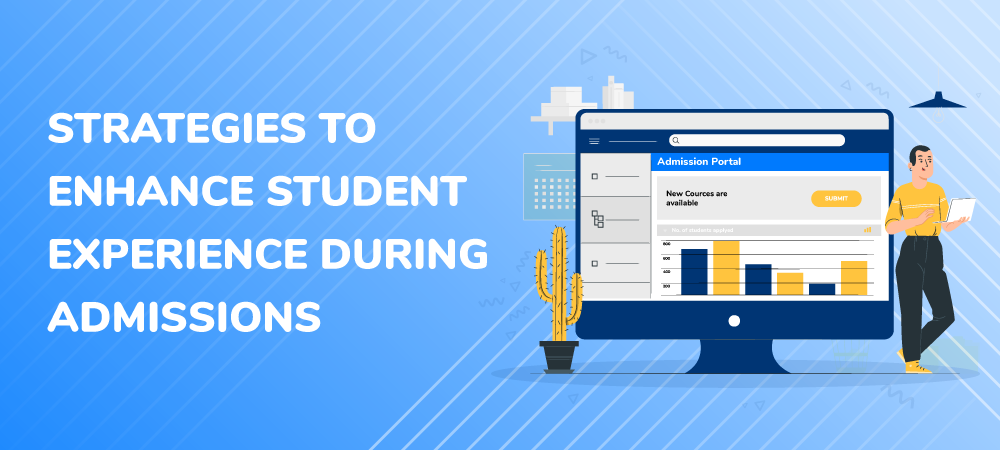
What are the things that lead to a great student experience?
Before we discuss that in detail, let us also acknowledge that since the pandemic, the education sector has seen a paradigm shift; not only do the students have more choices but several new touchpoints along the admission journey.
Educational institutions are now using technology extensively to drive admissions. For example, they run targeted email and ad campaigns, engage on social media, and much more. But when you reverse the roles and view these ads from a learners’ perspective, you see them swamped and overwhelmed with promotional emails from hundreds of institutions. It leads to more distractions and choices than ever before.
Thus, even if it is a digital interaction, you must create an impactful experience for students; in fact, even more so. A key differentiator (besides the quality of the education) would be a strategy to manage online admissions.
“The admission process is shifting to the digital space. There is a need to streamline and automate the process for counselors as well as students. Organizations are adopting an online student onboarding model that is also helping student counselors in closing admissions faster. There is a lot of personalization in the overall communication, and the admission process in 2021 will be even more evolved.”
– Rajiv Swarup, Former President, Shiv Nadar University
So, what exactly is digital student onboarding?
Digital student onboarding is the admission process that takes place almost exclusively online. It starts with the student applying for admissions online and continues till the student enrolls into your institution. It involves several touchpoints, such as virtual campus tours, financial aid discussion & grants, checking eligibility, ID verification, and access to premises/online classrooms.
How does digital onboarding impact student experience?
Let us take an example. Vivek is about to finish school and has started his search for top engineering colleges in India. He compiles a list of universities and adds your university to it. What’s more, he finds a way to access e-brochure, check eligibility, and apply online on your website. Just as he downloads the brochure, a counselor reaches out to him to guide him through his career goals and the admission process. This response is a positive student experience for Vivek. It gives him an impression that you care for him. In a way, it gives you a competitive advantage over other colleges that did not respond to his query.
Let us now say that Vivek has decided to enroll in one of your courses. Now, instead of filling lengthy forms, he can complete the application online and submit the documents. Next, you can verify the documents, check eligibility and approve his admission.
What used to take days and months and multiple campus visits is now possible in just a few clicks. Thus, digital onboarding plays an important role in enhancing the student experience.
However, the typical admission journey is long and complicated, with many steps involved in between. You have to cross several milestones to lead a student through enrollment. You must offer a personalized and enriching student experience throughout the journey. It is possible through an omnichannel approach to learner engagement and using a centralized lead management system.
6 Effective strategies to enhance student experience during admissions
1. Omni-channel student inquiry capture:
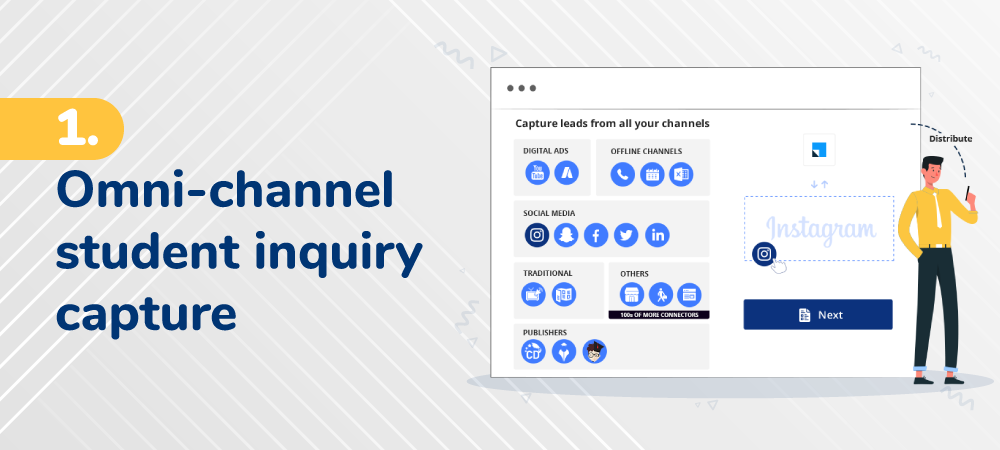
There are over a billion learners globally – each one looking for the right university for them. Gone are the days when colleges would find students through offline sources. Today, digital channels are becoming the most prominent source to get student inquiries.
Examples of these channels are social media, such as Instagram, Linkedin, or Facebook, and third-party marketplaces or publishers, such as Shiksha.com, Collegeduniya, Sulekha, etc.
With so many sources, generating student inquiries might not be that hard. But collating them from different platforms could be tedious, without an automated system. Also, tracking their status and following-up from individual channels can be very time-consuming and will delay responses. You will probably miss out on leads and follow-ups in the process, creating a negative impact on the student experience.
Solution: Using an integrated education CRM can help capture all the leads efficiently. With multiple social media and publisher integrations (Google Ads, Facebook, Chatbots, Shiksha.com, Collegeduniya, etc.), you can capture student inquiries from all available channels into a central system and pursue each of them from the CRM platform itself.
2. Entice students with creative marketing campaigns and follow-through
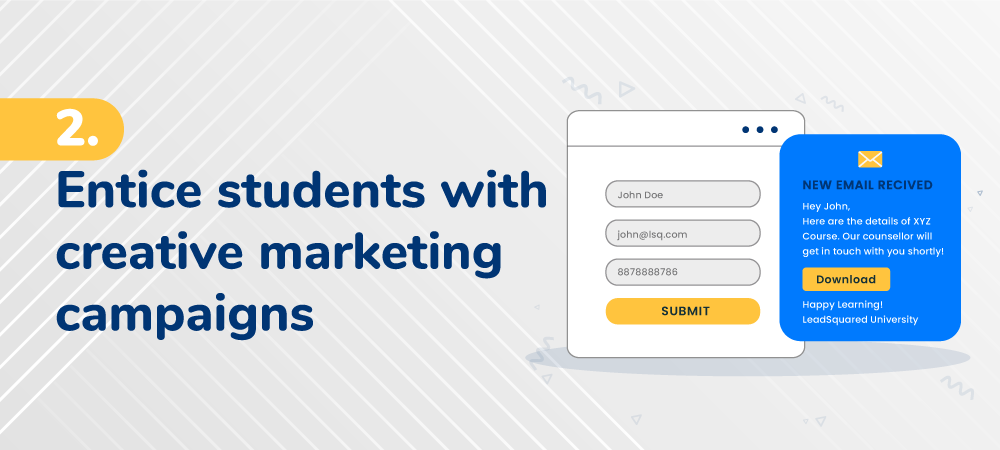
According to Statista, the number of global email users is set to grow to 4.48 billion users by 2024. It indicates that Email will remain the most effective channel of communication between business and consumers. Thus, make the most of your email marketing campaigns. These tips can help.
Marketing campaigns are not just for admissions but go a long way until graduation and beyond. Engaging with the student and parents along the student lifecycle will enhance the overall digital student experience. Great experience brings with it good word of mouth, which in turn, will inspire the upcoming batches to take admission in your institution.
So, you must identify the best offers, A/B test emails, ads, landing pages and find the best marketing channels for effective communication with students. Remember that the first impression matters the most. With the right messaging, you can improve the admission rate to a great extent. However, one must also remember that no matter how good a campaign is, delivering what is promised in your campaign will lead to a good student admission experience.
3. Use relevant, action-driven landing pages
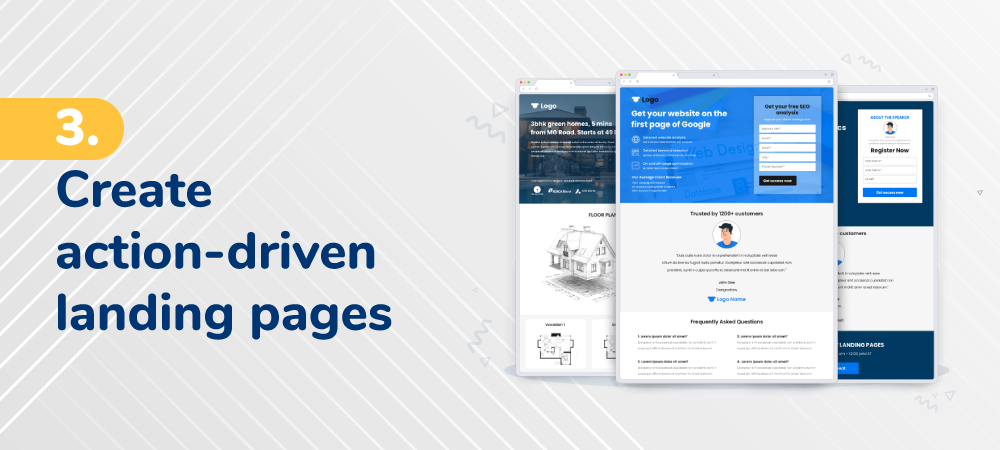
A landing page is a standalone web page created specifically for a marketing or advertising campaign. Landing Pages are an effective lead capture and conversion tool.
Universities can have landing pages for a specific campus, course, or offer. The messaging should encourage students to fill out the admission form. The following are the ways to create effective landing pages:
- Ensure your message matches your ads
- Keep the call-to-action above the fold
- Use directional cues to direct the eye
- Show your courses, testimonials from alumni to build trust
- Remove navigation and other distractions
- Use clear, compelling copy
- According to child rights NGO, Smile Foundation – 43.99% of students actively use smartphones. Therefore, make it mobile-friendly.
- Make it multi-lingual (if you’re targeting students across geographies)
But why do you need a landing page, and what role does it play in the student experience?
Building targeted landing pages makes your campaigns relevant for different courses, campuses, etc.
In terms of your strategy, you could judge what works and what not while creating digital campaigns. Moreover, you would be able to generate a detailed report on conversion analytics for high and low- performing keywords, traffic sources, locations, and more. It can help you make data-driven marketing decisions.
To make the most of your landing page, keep it precise. Having multiple lead capture fields will only increase the drop-off rate. To increase engagement, send an automated acknowledgment email to the student when he submits his details on the landing page.
4. Boost student experience using paperless portals
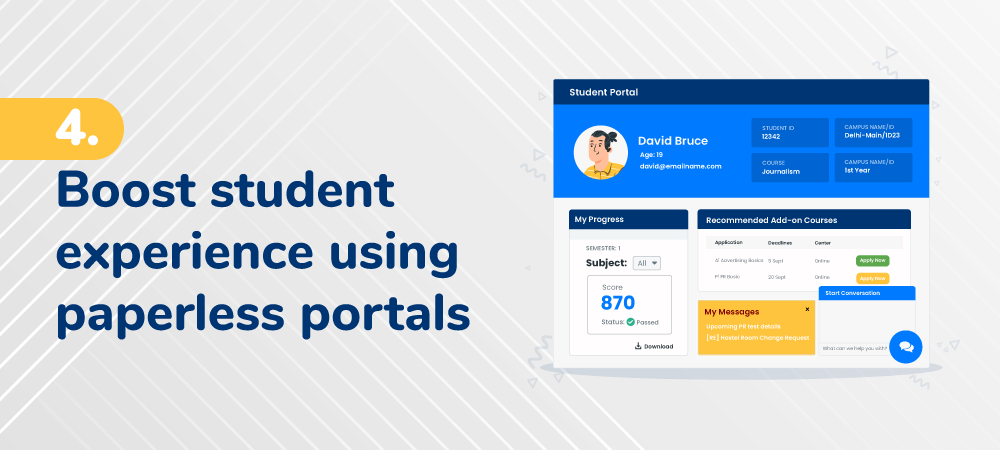
Paperless applicant portals help make the application journey easy for students. For instance, a student-friendly form will always have a higher completion rate.
Paperless application portals have two-fold benefits. It lets students apply online – without having to wait in queues just for submitting the application form. And it makes it easy for the counselor to fetch the student information in the correct format. Moreover, you can access the data for multiple purposes – from checking eligibility to enrollment and placements. It eliminates the need for a separate data entry operator. And students don’t need to share the details again and again with the administrators.
With the help of a student portal, you can:
- Create a responsive student application portal: Make it easy for students to manage their profiles, upload documents, get updates on their applications, and more. If they drop-off without completing the application, they should be able to resume it anytime. The portal also notifies your admission department/call-center team to follow-up with the students when they don’t complete the application. Plus, you can use the portal to convey placement and alumni-related information.
- Design a mobile-friendly application: According to research from RescueTime, people spend over four-and-a-half hours on their cellphone per day. This reinforces the importance of a mobile-friendly application. The portal should allow students to upload documents, sign applications, check application status, and make payments from any device.
- Power up your enrollment process with automation: An automated enrollment portal collects and processes all applicant details, documents, payments, and e-signatures, cutting down a significant amount of administrative work.
- Collect signatures and documents electronically: While applicants can upload mark sheets, e-sign, etc., counselors can access those documents and save countless hours of paperwork.
All of this will ensure that your digital native students can complete their applications with ease. Counselors can jump in to aid them only when needed. This can go a long way in enhancing the student experience.
5. Leverage digital touchpoints:
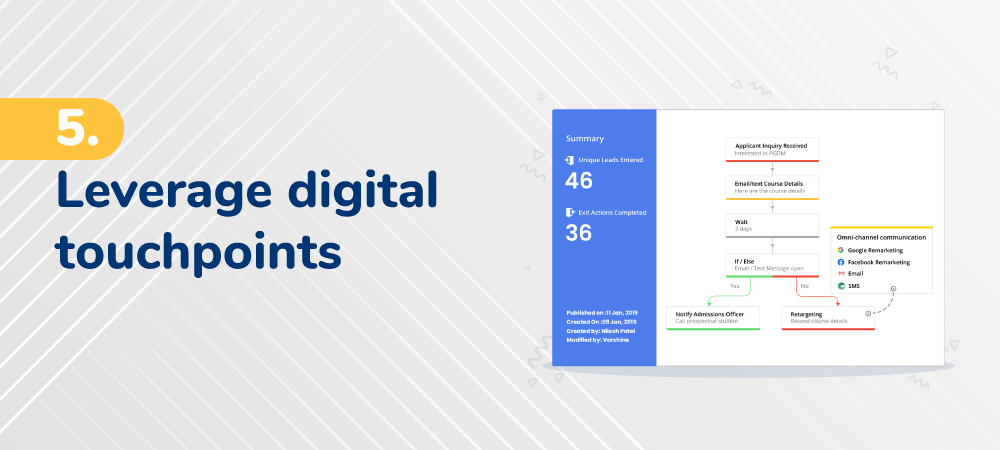
According to Chilipiper, contacting a person within 5 minutes of an inquiry increases the chances of conversion by nine times. However, it is impossible to sit in front of a system and send out targeted messages to students/parents who inquire about your courses. An effective solution to this is automating the touchpoints.
So, how to do that?
Use automation to build an engaging digital student journey – with minimum human intervention. So no matter how or when a student fills out a form, the system automatically engages with the applicant till a relevant student counselor reaches out to them.
For example, if a student signs up on your website, the admission management system can automatically send out relevant messages, such as welcome emails, brochures, and more. You can initiate this communication via WhatsApp messages, emails, or SMS. If the student does not respond, the system can send a notification to the admission team to follow-up. The point is – once you have identified different touchpoints along the student journey, you can create automated workflows for the admission process.
6. Prioritize student inquiries:
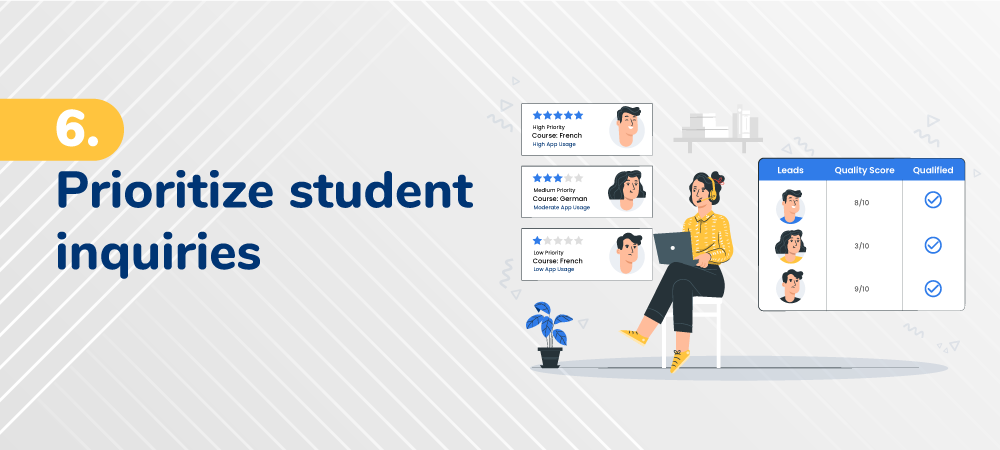
One of the biggest concerns for educational institutions is to figure out whom to approach first. How to prioritize student inquiries that have a higher chance of conversion? It is common for educational institutions to receive hundreds of inquiries/day during the admission season. And it is practically impossible to call every lead.
Thus, it may result in missing out on follow-up calls and admission opportunities. A study by Microsoft reveals 56% of respondents stopped interactions with a brand due to a poor customer service experience. 47% of these consumers preferred moving to the competitor. These numbers are enough to convince you not to keep the student inquiries waiting.
How can you prioritize inquiries?
Let me explain it with an example.
LeadSquared Education CRM has a lead scoring mechanism. It lets you assign scores automatically to inquiries based on the courses explored, applied for enrollment, and so on. For instance, a student who has downloaded the brochure will have a higher lead score than the student who just browsed your home page.
Thus, lead scoring helps you identify the students who are more interested in admission. This way, you can prioritize follow-ups with them.
Also, you can segment the inquiries into specific buckets based on their stage in the application process (for example, inquiries, applications, opportunities, students, etc.). The CRM system automatically moves them in the respective buckets based on your interactions with them. This way, the admission counselors know how to assist the students and move them forward in the admission cycle.
The bottom line
India’s NEP and the change in educational models due to COVID have compelled institutions to adopt technology faster. Universities, Schools, EdTechs, and other educational institutions across cities, towns, and villages have started to adapt to the online education model. Seamless student onboarding experience and personalized treatment can help build your institution’s image as a trusted one and boost admission rates.
Although the education sector may seem saturated and dominated by leading players, the right strategy and tools can improve the student experience and hence, admission rates.
If you are looking for a solution to improve the student experience, check out LeadSquared Education CRM. It has helped several leading institutions streamline their admission process.
FAQs
The experience does not start only when the student pays the fee. It begins with the admission inquiry raised with the institution and continues till graduation. Here are a few things you can do to provide a superior student experience:
1. Respond to their queries immediately
2. Personalize communication
3. Address their grievances (after admission)
4. Help them achieve their career goals by supporting them in their pursuit.
You can increase the admission rates by improving the student experience. Also, try to reduce the student TAT. Using the right set of sales and marketing tools, you can enhance the student experience and increase your admission rates.








